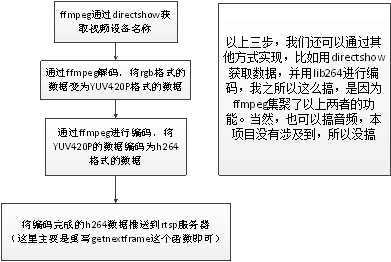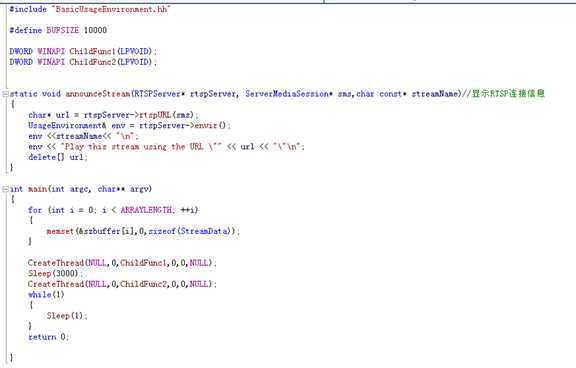#include "global.h"
#include "FFmpegReadCamera.h"
#include "H264LiveVideoServerMediaSubssion.hh"
#include "H264FramedLiveSource.hh"
#include "liveMedia.hh"
#include "BasicUsageEnvironment.hh"
?
#define BUFSIZE 10000
?
DWORD WINAPI ChildFunc1(LPVOID);
DWORD WINAPI ChildFunc2(LPVOID);
?
?
static
void announceStream(RTSPServer* rtspServer, ServerMediaSession* sms,char
const* streamName)//显示RTSP连接信息
{
???char* url = rtspServer->rtspURL(sms);
???UsageEnvironment& env = rtspServer->envir();
???env <<streamName<< "\n";
???env << "Play this stream using the URL \"" << url << "\"\n";
???delete[] url;
}
?
int main(int argc, char** argv)
{
???for (int i = 0; i < ARRAYLENGTH; ++i)
???{
??????memset(&szbuffer[i],0,sizeof(StreamData));
???}
?
???CreateThread(NULL,0,ChildFunc1,0,0,NULL);
???Sleep(3000);
???CreateThread(NULL,0,ChildFunc2,0,0,NULL);
???while(1)
???{
??????Sleep(1);
???}
????return 0;
?
}
?
DWORD WINAPI ChildFunc1(LPVOID p)
{
???int ret;
???AVFormatContext *ofmt_ctx = NULL;
???AVStream *out_stream;
???AVStream *in_stream;
???AVCodecContext *enc_ctx;
???AVCodecContext *dec_ctx;
???AVCodec* encoder;
???enum AVMediaType type;
???fp_write = fopen("test.h264","wb+");
???unsigned int stream_index;
???AVPacket enc_pkt;
???int enc_got_frame;
?
???AVFormatContext *pFormatCtx;
???int i, videoindex;
???AVCodecContext *pCodecCtx;
???AVCodec *pCodec;
?
???av_register_all();
?
???avformat_network_init();
???pFormatCtx = avformat_alloc_context();
?
???avformat_alloc_output_context2(&ofmt_ctx,NULL,"h264",NULL);
?
???//Register Device 注册所有硬件
???avdevice_register_all();
???//Show Dshow Device 显示所有可用的硬件
???show_dshow_device();
???//Show Device Options 显示某一个硬件的所有参数(摄像头参数)
???show_dshow_device_option();
???//Show VFW Options
???show_vfw_device();
???//Windows
#ifdef _WIN32
#if USE_DSHOW
???AVInputFormat *ifmt=av_find_input_format("dshow");
???//Set own video device‘s name
???if(avformat_open_input(&pFormatCtx,"video=Integrated Webcam",ifmt,NULL)!=0){
??????printf("Couldn‘t open input stream.(无法打开输入流)\n");
??????return -1;
???}
#else
???AVInputFormat *ifmt=av_find_input_format("vfwcap");
???if(avformat_open_input(&pFormatCtx,"0",ifmt,NULL)!=0){
??????printf("Couldn‘t open input stream.(无法打开输入流)\n");
??????return -1;
???}
#endif
#endif
???//Linux
#ifdef linux
???AVInputFormat *ifmt=av_find_input_format("video4linux2");
???if(avformat_open_input(&pFormatCtx,"/dev/video0",ifmt,NULL)!=0){
??????printf("Couldn‘t open input stream.(无法打开输入流)\n");
??????return -1;
???}
#endif
?
?
???if(avformat_find_stream_info(pFormatCtx,NULL)<0)
???{
??????printf("Couldn‘t find stream information.(无法获取流信息)\n");
??????return -1;
???}
???videoindex=-1;
???for(i=0; i<pFormatCtx->nb_streams; i++)
??????if(pFormatCtx->streams[i]->codec->codec_type==AVMEDIA_TYPE_VIDEO)
??????{
?????????videoindex=i;
?????????break;
??????}
??????if(videoindex==-1)
??????{
?????????printf("Couldn‘t find a video stream.(没有找到视频流)\n");
?????????return -1;
??????}
?
??????pCodecCtx=pFormatCtx->streams[videoindex]->codec;
??????pCodec=avcodec_find_decoder(pCodecCtx->codec_id);
??????if(pCodec==NULL)
??????{
?????????printf("Codec not found.(没有找到解码器)\n");
?????????return -1;
??????}
??????if(avcodec_open2(pCodecCtx, pCodec,NULL)<0)
??????{
?????????printf("Could not open codec.(无法打开解码器)\n");
?????????return -1;
??????}
?
??????AVFrame *pFrame,*pFrameYUV;
??????pFrame=avcodec_alloc_frame();
??????pFrameYUV=avcodec_alloc_frame();
??????int length = avpicture_get_size(PIX_FMT_YUV420P, pCodecCtx->width, pCodecCtx->height);
??????uint8_t *out_buffer=(uint8_t *)av_malloc(length);
?
?
??????/*open output file*/
??????AVIOContext *avio_out = avio_alloc_context(out_buffer,length,0,NULL,NULL,write_buffer,NULL);
??????if (avio_out == NULL)
??????{
?????????printf("申请内存失败! \n");
?????????return -1;
??????}
?
??????ofmt_ctx->pb = avio_out;
??????ofmt_ctx->flags = AVFMT_FLAG_CUSTOM_IO;
??????for(int i = 0; i < 1; i++)
??????{
?????????out_stream = avformat_new_stream(ofmt_ctx,NULL);
?????????if (!out_stream)
?????????{
????????????av_log(NULL,AV_LOG_ERROR,"failed allocating output stream");
????????????return AVERROR_UNKNOWN;
?????????}
?????????in_stream = pFormatCtx->streams[i];
?????????dec_ctx = in_stream->codec;
?????????enc_ctx = out_stream->codec;
?????????//设置编码格式
?????????if (dec_ctx->codec_type == AVMEDIA_TYPE_VIDEO)
?????????{
????????????encoder = avcodec_find_encoder(AV_CODEC_ID_H264);
????????????enc_ctx->height = dec_ctx->height;
????????????enc_ctx->width = dec_ctx->width;
????????????enc_ctx->sample_aspect_ratio = dec_ctx->sample_aspect_ratio;
????????????enc_ctx->pix_fmt = encoder->pix_fmts[0];
????????????enc_ctx->time_base = dec_ctx->time_base;
????????????enc_ctx->me_range = 16;
????????????enc_ctx->max_qdiff = 4;
????????????enc_ctx->qmin = 10;//10 这两个值调节清晰度
????????????enc_ctx->qmax = 51;//51
????????????enc_ctx->qcompress = 0.6;
????????????enc_ctx->refs = 3;
????????????enc_ctx->bit_rate = 500000;
?
????????????//enc_ctx->time_base.num = 1;
????????????//enc_ctx->time_base.den = 25;
????????????//enc_ctx->gop_size = 10;
????????????//enc_ctx->bit_rate = 3000000;
?
????????????ret = avcodec_open2(enc_ctx,encoder,NULL);
????????????if (ret < 0)
????????????{
???????????????av_log(NULL,AV_LOG_ERROR,"Cannot open video encoder for stream #%u\n",i);
???????????????return ret;
????????????}
????????????//av_opt_set(enc_ctx->priv_data,"tune","zerolatency",0);
?????????}
?????????else
if (dec_ctx->codec_type == AVMEDIA_TYPE_UNKNOWN)
?????????{
????????????av_log(NULL, AV_LOG_FATAL, "Elementary stream #%d is of unknown type, cannot proceed\n", i);
????????????return AVERROR_INVALIDDATA;
?????????}
?????????else
?????????{
????????????// if this stream must be remuxed
????????????ret = avcodec_copy_context(ofmt_ctx->streams[i]->codec,pFormatCtx->streams[i]->codec);
????????????if (ret < 0)
????????????{
???????????????av_log(NULL, AV_LOG_ERROR, "Copying stream context failed\n");
???????????????return ret;
????????????}
?????????}
?????????if (ofmt_ctx->oformat->flags & AVFMT_GLOBALHEADER)
?????????{
????????????enc_ctx->flags |= CODEC_FLAG_GLOBAL_HEADER;
?????????}
??????}
??????// init muxer, write output file header
??????ret = avformat_write_header(ofmt_ctx,NULL);
??????if (ret < 0)
??????{
?????????if (ret < 0)
?????????{
????????????av_log(NULL, AV_LOG_ERROR, "Error occurred when opening output file\n");
????????????return ret;
?????????}
??????}
?
??????i = 0;
??????// pCodecCtx 解码的codec_context
??????avpicture_fill((AVPicture *)pFrameYUV, out_buffer, PIX_FMT_YUV420P, pCodecCtx->width, pCodecCtx->height);
??????//SDL----------------------------
??????if(SDL_Init(SDL_INIT_VIDEO | SDL_INIT_AUDIO | SDL_INIT_TIMER)) {
?????????printf( "Could not initialize SDL - %s\n", SDL_GetError());
?????????return -1;
??????}
??????int screen_w=0,screen_h=0;
??????SDL_Surface *screen;
??????screen_w = pCodecCtx->width;
??????screen_h = pCodecCtx->height;
??????screen = SDL_SetVideoMode(screen_w, screen_h, 0,0);
?
??????if(!screen) {
?????????printf("SDL: could not set video mode - exiting:%s\n",SDL_GetError());
?????????return -1;
??????}
??????SDL_Overlay *bmp;
??????bmp = SDL_CreateYUVOverlay(pCodecCtx->width, pCodecCtx->height,SDL_YV12_OVERLAY, screen);
??????SDL_Rect rect;
??????//SDL End------------------------
??????int got_picture;
?
??????AVPacket *packet=(AVPacket *)av_malloc(sizeof(AVPacket));
??????//Output Information-----------------------------
??????printf("File Information(文件信息)---------------------\n");
??????av_dump_format(pFormatCtx,0,NULL,0);
??????printf("-------------------------------------------------\n");
?
#if OUTPUT_YUV420P
??????FILE *fp_yuv=fopen("output.yuv","wb+");
#endif
?
??????struct SwsContext *img_convert_ctx;
??????img_convert_ctx = sws_getContext(pCodecCtx->width, pCodecCtx->height, pCodecCtx->pix_fmt, pCodecCtx->width, pCodecCtx->height, PIX_FMT_YUV420P, SWS_BICUBIC, NULL, NULL, NULL);
??????//------------------------------
??????//read all packets
??????while(av_read_frame(pFormatCtx, packet)>=0)
??????{
?????????if(packet->stream_index==videoindex)
?????????{
?
????????????type = pFormatCtx->streams[packet->stream_index]->codec->codec_type;
????????????stream_index = packet->stream_index;
????????????av_log(NULL, AV_LOG_DEBUG, "Demuxer gave frame of stream_index %u\n",stream_index);
?
????????????if (!pFrame)
????????????{
???????????????ret = AVERROR(ENOMEM);
???????????????break;
????????????}
????????????packet->dts = av_rescale_q_rnd(packet->dts,
???????????????pFormatCtx->streams[stream_index]->time_base,
???????????????pFormatCtx->streams[stream_index]->codec->time_base,
???????????????(AVRounding)(AV_ROUND_NEAR_INF|AV_ROUND_PASS_MINMAX));
????????????packet->pts = av_rescale_q_rnd(packet->pts,
???????????????pFormatCtx->streams[stream_index]->time_base,
???????????????pFormatCtx->streams[stream_index]->codec->time_base,
???????????????(AVRounding)(AV_ROUND_NEAR_INF|AV_ROUND_PASS_MINMAX));
????????????ret = avcodec_decode_video2(pCodecCtx, pFrame, &got_picture, packet);
????????????printf("Decode 1 Packet\tsize:%d\tpts:%d\n",packet->size,packet->pts);
????????????if(ret < 0)
????????????{
???????????????printf("Decode Error.(解码错误)\n");
???????????????av_frame_free(&pFrame);
???????????????return -1;
????????????}
????????????if(got_picture)
????????????{
???????????????//这句话是转换格式的函数,可用将rgb变为yuv格式
???????????????sws_scale(img_convert_ctx, (const
uint8_t* const*)pFrame->data, pFrame->linesize, 0, pCodecCtx->height, pFrameYUV->data, pFrameYUV->linesize);
???????????????//下面对转换为YUV格式的AVFramer进行编码即可
???????????????pFrameYUV->width = pFrame->width;
???????????????pFrameYUV->height = pFrame->height;
?
???????????????/*pFrameYUV->pts = av_frame_get_best_effort_timestamp(pFrameYUV);
???????????????pFrameYUV->pict_type = AV_PICTURE_TYPE_NONE;*/
?
???????????????enc_pkt.data = NULL;
???????????????enc_pkt.size = 0;
???????????????av_init_packet(&enc_pkt);
???????????????enc_pkt.data = out_buffer;
???????????????enc_pkt.size = length;
?
???????????????//编码必须是YUV420P格式,不然编码不会成功。
???????????????ret = avcodec_encode_video2(ofmt_ctx->streams[stream_index]->codec,&enc_pkt,pFrameYUV,&enc_got_frame);
???????????????printf("Encode 1 Packet\tsize:%d\tpts:%d\n",enc_pkt.size,enc_pkt.pts);
???????????????if (ret == 0) //一定要记得 ret 值为0 ,代表成功。-1 才是代表失败。
???????????????{
??????????????????fwrite(enc_pkt.data,enc_pkt.size,1,fp_write); //存储编码后的h264文件,可以作为测试用
??????????????????memcpy(szbuffer[recvcount].str,enc_pkt.data,enc_pkt.size);
??????????????????szbuffer[recvcount].len = enc_pkt.size;
??????????????????recvcount = (recvcount + 1)%ARRAYLENGTH;
???????????????}
???????????????if (ret < 0)
???????????????{
??????????????????printf("encode failed");
??????????????????return -1;
???????????????}
???????????????if (!enc_got_frame)
???????????????{
??????????????????continue;
???????????????}
?
???????????????/* prepare packet for muxing */
???????????????enc_pkt.stream_index = stream_index;
???????????????enc_pkt.dts = av_rescale_q_rnd(enc_pkt.dts,
??????????????????ofmt_ctx->streams[stream_index]->codec->time_base,
??????????????????ofmt_ctx->streams[stream_index]->time_base,
??????????????????(AVRounding)(AV_ROUND_NEAR_INF|AV_ROUND_PASS_MINMAX));
???????????????enc_pkt.pts = av_rescale_q_rnd(enc_pkt.pts,
??????????????????ofmt_ctx->streams[stream_index]->codec->time_base,
??????????????????ofmt_ctx->streams[stream_index]->time_base,
??????????????????(AVRounding)(AV_ROUND_NEAR_INF|AV_ROUND_PASS_MINMAX));
???????????????enc_pkt.duration = av_rescale_q(enc_pkt.duration,
??????????????????ofmt_ctx->streams[stream_index]->codec->time_base,
??????????????????ofmt_ctx->streams[stream_index]->time_base);
???????????????av_log(NULL, AV_LOG_INFO, "Muxing frame %d\n",i);
???????????????/* mux encoded frame */
???????????????av_write_frame(ofmt_ctx,&enc_pkt);
???????????????if (ret < 0)
???????????????{
??????????????????printf("encode failed");
??????????????????return -1;
???????????????}
?
#if OUTPUT_YUV420P
???????????????int y_size=pCodecCtx->width*pCodecCtx->height;
???????????????fwrite(pFrameYUV->data[0],1,y_size,fp_yuv); //Y
???????????????fwrite(pFrameYUV->data[1],1,y_size/4,fp_yuv); //U
???????????????fwrite(pFrameYUV->data[2],1,y_size/4,fp_yuv); //V
#endif
???????????????SDL_LockYUVOverlay(bmp);
???????????????bmp->pixels[0]=pFrameYUV->data[0];
???????????????bmp->pixels[2]=pFrameYUV->data[1];
???????????????bmp->pixels[1]=pFrameYUV->data[2];
???????????????bmp->pitches[0]=pFrameYUV->linesize[0];
???????????????bmp->pitches[2]=pFrameYUV->linesize[1];
???????????????bmp->pitches[1]=pFrameYUV->linesize[2];
???????????????SDL_UnlockYUVOverlay(bmp);
???????????????rect.x = 0;
???????????????rect.y = 0;
???????????????rect.w = screen_w;
???????????????rect.h = screen_h;
???????????????SDL_DisplayYUVOverlay(bmp, &rect);
???????????????//Delay 40ms
???????????????SDL_Delay(40);
????????????}
?????????}
?????????av_free_packet(packet);
??????}
?
??????/* flush encoders */
??????for (i = 0; i < 1; i++) {
?????????/* flush encoder */
?????????ret = flush_encoder(ofmt_ctx,i);
?????????if (ret < 0) {
????????????av_log(NULL, AV_LOG_ERROR, "Flushing encoder failed\n");
????????????return -1;
?????????}
??????}
??????av_write_trailer(ofmt_ctx);
?
??????sws_freeContext(img_convert_ctx);
?
#if OUTPUT_YUV420P
??????fclose(fp_yuv);
#endif
?
??????SDL_Quit();
?
??????av_free(out_buffer);
??????av_free(pFrameYUV);
??????avcodec_close(pCodecCtx);
??????avformat_close_input(&pFormatCtx);
??????//fcloseall();
??????return 0;
}
?
DWORD WINAPI ChildFunc2(LPVOID p)
{
???//设置环境
???UsageEnvironment* env;
???Boolean reuseFirstSource = False;//如果为"true"则其他接入的客户端跟第一个客户端看到一样的视频流,否则其他客户端接入的时候将重新播放
???TaskScheduler* scheduler = BasicTaskScheduler::createNew();
???env = BasicUsageEnvironment::createNew(*scheduler);
?
???//创建RTSP服务器
???UserAuthenticationDatabase* authDB = NULL;
???RTSPServer* rtspServer = RTSPServer::createNew(*env, 8554, authDB);
???if (rtspServer == NULL) {
??????*env << "Failed to create RTSP server: " << env->getResultMsg() << "\n";
??????exit(1);
???}
???char
const* descriptionString= "Session streamed by \"testOnDemandRTSPServer\"";
?
???//模拟实时流发送相关变量
???int datasize;//数据区长度
???unsigned char* databuf;//数据区指针
???databuf = (unsigned char*)malloc(100000);
???bool dosent;//rtsp发送标志位,为true则发送,否则退出
?
???//从文件中拷贝1M数据到内存中作为实时网络传输内存模拟,如果实时网络传输应该是双线程结构,记得在这里加上线程锁
???//此外实时传输的数据拷贝应该是发生在H264FramedLiveSource文件中,所以这里只是自上往下的传指针过去给它
????datasize = szbuffer[(recvcount+ARRAYLENGTH-1)%ARRAYLENGTH].len;
???for (int i = 0; i < datasize; ++i)
???{
??????databuf[i] = szbuffer[(recvcount+ARRAYLENGTH-1)%ARRAYLENGTH].str[i];
???}
???dosent = true;
???//fclose(pf);
?
???//上面的部分除了模拟网络传输的部分外其他的基本跟live555提供的demo一样,而下面则修改为网络传输的形式,为此重写addSubsession的第一个参数相关文件
???char
const* streamName = "h264test";
???ServerMediaSession* sms = ServerMediaSession::createNew(*env, streamName, streamName,descriptionString);
???sms->addSubsession(H264LiveVideoServerMediaSubssion::createNew(*env, reuseFirstSource, &datasize, databuf,&dosent));//修改为自己实现的H264LiveVideoServerMediaSubssion
???rtspServer->addServerMediaSession(sms);
???announceStream(rtspServer, sms, streamName);//提示用户输入连接信息
?
???env->taskScheduler().doEventLoop(); //循环等待连接(没有链接的话,进不去下一步,无法调试)
?
???free(databuf);//释放掉内存
???return 0;
}


